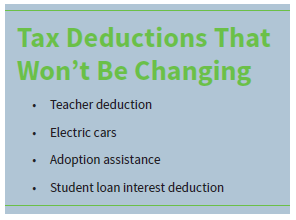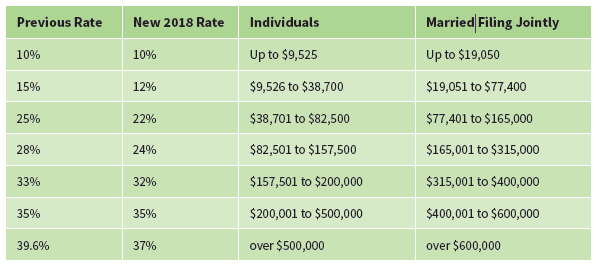New tax laws affect us all, like it or not. Deciphering what a law means in your situation can be difficult. In this post, we explain some tax law changes from the Tax Cuts and Jobs Act. Because this new bill went into effect January 1, 2018, you may notice changes when you file your 2018 tax return. In plain English, here’s what this tax bill could mean for you.
Three Key Changes
For Employees. You may receive a smaller refund, or even owe additional tax. The new law has changed how withholding amounts are calculated for employee paychecks. If you’re concerned about how your paycheck withholdings may affect your 2018 tax return, you should talk to your tax preparer.
New Tax Rates. Many tax brackets have a new, lower tax rate. The 10% bracket remains at 10%; the 15% bracket is now 12%; the 25% bracket is now 22%; the 28% bracket is now 24%; the 33% bracket is now 32%; the 35% bracket is unchanged; the 39.6% bracket is now 37%. See last page for table.
Higher Standard Deduction. The standard deduction for a single filer has increased from $6,350 to $12,000, and for a married couple, from $12,700 to $24,000. With this higher standard deduction, you may not have enough deductions to itemize. You can skip the itemization and take the standard deduction instead.
Individuals: What to Expect
Child Tax Credit. The child tax credit has increased from $1,000 per child to $2,000 per child, for children 16 years old and younger. You can’t receive more than $1,400 per child as a refund if you owe less tax than the credit, since the refundable portion is limited. In addition, the income limit for the child tax credit has increased from $75,000 to $200,000 for singles, and from $110,000 to $400,000 for married couples.
Family Credit. New this year is a family credit for dependents older than 16. This credit is $500 per dependent and is nonrefundable. (If you owe less tax than the credit, you won’t receive the credit as a refund.)
State, Local, and Real Estate Deductions. You can itemize and deduct a maximum of $10,000 of your state, local, and real estate taxes.
Medical Expenses. You can deduct more medical expenses for 2018 because of a lower threshold for adjusted gross income (AGI). Medical expenses exceeding 7.5% of your AGI for 2018 can be itemized. For 2019 the AGI threshold will return to the previous 10%.
Health Insurance Penalties. Relief is coming for people without health insurance or an approved exemption. Starting with tax year 2019, the penalty for not having minimum health coverage will end.
Eliminated Deductions and Exemptions. You can no longer deduct miscellaneous itemized deductions. This includes tax preparation fees for individuals (tax preparation for farms and businesses is still deductible). Unreimbursed employee expenses, such as per diem for truck drivers, and moving expenses are no longer deductible. Personal exemptions have been discontinued.
School Tuition Savings. Tuition savings plans such as the 529 plan can be used to pay for elementary and secondary school expenses, up to $10,000 per year. Payments to private religious schools are also included. (A 529 plan provides tax savings because your contributions and interest earnings are exempt from state tax.)
Businesses: What to Expect
Entertainment and Meals. You can no longer deduct entertainment expenses for customers, vendors, or other business associates. Meals are 50% deductible if there was a business purpose. Christmas dinners and company picnics are still 50% deductible.
Equipment Purchases. You can expense up to $1,000,000 of equipment purchased in a year for your business. This amount begins to phase out if more than $2,500,000 is purchased during the year.
Self-Employment Deduction. A 20% deduction is available if you have qualified business income from a partnership, S-corporation, or sole proprietorship. This deduction begins to phase out at $157,500 for single filers and $315,000 for married couples, unless the business had either W-2 wages or tangible property subject to depreciation. Above the phase-out amounts, various calculations are used to determine the deduction.
Trading Tangible Property. You can no longer do a tax-deferred trade, or 1031 exchange, of tangible business property. An exchange can still be used for real estate, but not for equipment.
NOL. You cannot carry back a Net Operating Loss (NOL) to prior years, unless it is a farming NOL, which can be carried back 2 years. NOL’s can be carried forward indefinitely, but they can only be used to offset 80% of taxable income in any future year.
Cash Basis Accounting. Does your business have gross receipts that average $25 million or less each year for the last 3 taxable years? Then you are permitted to use the cash method of accounting.
Tax Rate for C-Corporations. The tax rate is now 21% for C-corporations, a significant decrease from the previous rate of 35%.
New Rates for Tax Brackets
Why Reform?
According to US representatives, the tax reform bill was intended to:
• Simplify the tax process
• Preserve the mortgage interest deduction
• Eliminate Obamacare’s individual mandate penalty tax
• Increase the standard deduction
• Provide more support to American families
• Provide relief for Americans with expensive medical bills
• Improve savings vehicles for education
What’s Next?
Although this is not an all-inclusive list of changes from the Tax Cuts and Jobs Act, we have highlighted ones that will affect our clients. We are still awaiting IRS regulations to learn how the IRS will apply these new laws. As always, please contact us with any questions you may have.
Topics: Tax

Austin Weaver
Austin Weaver is the Marketing Manager for Gehman Accounting. He helps small business owners find expert outsourced accounting solutions. Austin has had valuable experience in several industries including retail, design, food, manufacturing, and education.







